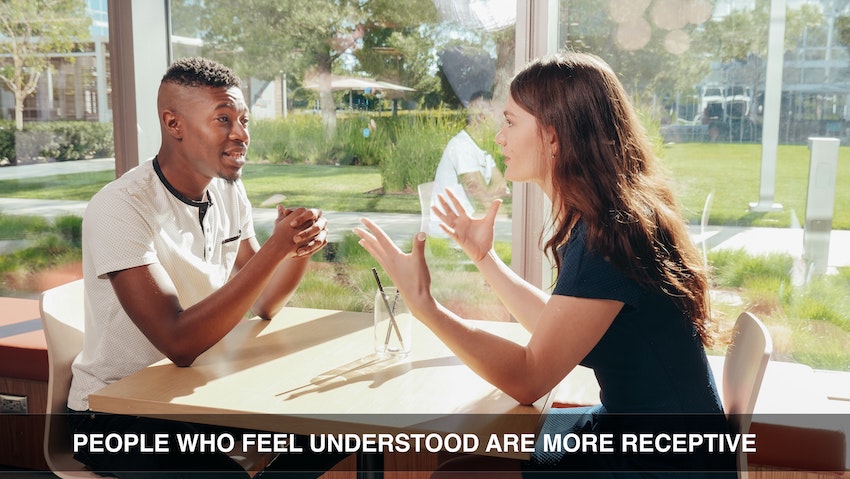The Feedback Sandwich Is Toast: Modern Strategies For Giving Effective Feedback
Master Feedback Delivery That Works
Refine your communication skills by learning to harness your emotional intelligence with one of the UK's most acclaimed management training courses.
Why Choose This Training?
More Than Just A Course Of Lectures
What gets in the way of developing and holding on to new communication skills are old habits of thinking and speaking. Even if the advice is very good the reason why it rarely sticks are the mental habits people inevitably revert to, especially under pressure.
Unlearning those old habits and internalising a more effective and lasting approach to communication needs more than a short course of lectures on how to do it.
What Makes This Training Stand Out?
What makes this training stand out is the exceptional support through one-to-one coaching sessions and continuous feedback. Changing behaviour is not an easy task as old habits are hard to break.
With a 40-year track record we can help you cultivate practical skills, and build your confidence to so you can successfully navigate real-world challenges, ensuring lasting behavioural improvements.
Testimonials
Join thousands of participants getting results
"What I love about this course is that I didn't just learn about the topic, this course is about ME. I'm confident I can reliably use my new skills, even when under pressure".
![]()
"A lesson for life! The power of effective communication is incredible when one masters the skills "listening with empathy" and "speaking assertively"
![]()
Clients We Have Worked With
Well-known companies who have used this course again and again, over many years
Course Summary
Training Objectives
Giving feedback is hard. A fact: the Feedback Sandwich method, once popular, is losing its charm. This training course will guide you through newer, more effective ways to give feedback that actually works. You’ll learn the secret sauce.
- The Feedback Sandwich method mixes good and bad comments but it's confusing. People can miss the main message.
- Clear talks about work and how to get better are best. They help people trust and understand feedback more.
- Regular, honest chats boost team spirit and job performance. Everyone knows where they stand.
- Praise should be real and about actual work done well. Too much mixed with criticism makes it feel less true.
- Training teaches managers to talk openly and listen well. This helps teams grow stronger together.
Develop Your Emotional Intelligence
You will learn a set of powerful emotional intelligence communication techniques so that you can manage difficult conversations, handle challenging situations, build relationships and set firm boundaries.
Transferable Skills
The goal of this training is to equip you with the tools you need to build strong, lasting relationships in your professional life, although because these skills are so transferable many clients report vast improvements in their personal relationships as well.
Develop Skills
This is a skills development rather than just a theoretical programme, so the emphasis throughout will be on you taking turn after turn, practising your skills, while receiving feedback and coaching about your effect on others.
Repeated Practice and Feedback
In your coaching sessions you will be helped to practise dealing with the kinds of situation you find challenging, again and again, until you are confident you can do it successfully.
Video Analysis
We'll combine practical, hands-on experience with video replay and analysis and discussion of the principles involved to help you gain both skills and understanding. Special attention is paid to your individual training needs, so you can practise your skills in real-life situations that you have to handle at work.
Sustained Change
That's why as well as your place in a small group, this training includes a generous amount of private and confidential one-to-one coaching sessions online, spread over several months, ensuring an exceptional level of support. This will ensure the changes you make are sustained over a longer period of time and any obstacles are overcome. Choose between online training available worldwide, or in-person face-to-face courses in the UK.
Course Dates and Price
For a list of upcoming course dates (for online coaching and face-to-face training), the locations of the next 3-day public courses in the UK and pricing Click here.
Free Initial Session
This initial coaching session serves as an introduction to the "Skills with People" course, allowing you to understand the course's relevance and effectiveness for your specific needs before committing to it.

The Problem with the Feedback Sandwich Approach
The Feedback Sandwich Approach tries to hide criticism between praise, but it's not that tasty. It often confuses people more than it helps.
Definition of the Feedback Sandwich
A feedback sandwich is a way of giving advice. It starts with something positive, then mentions what needs improvement, and ends on another positive note. People use this method hoping to make hearing the tough bits easier.
In practice, you might praise an employee for being reliable before suggesting they manage their time better and finish by commending their teamwork skills. This technique aims to create a balance between good and not-so-good feedback, making critical points seem less harsh.
Examples of the Feedback Sandwich
So, the feedback sandwich is toast. Out with the old and in with better strategies for providing effective feedback. Here's a look at examples of how this well-known approach often plays out:
- "You're doing great with your sales numbers this month... but we need to work on your punctuality... though, you're really good at managing client relationships." This starts and ends with positive feedback, but the critical part about punctuality might get lost in the mix.
- During a team meeting, a manager says, "I loved your presentation style in today's briefing; however, you missed discussing our quarterly goals. Keep up the enthusiasm though!" Here, praise wraps around a core critique that could be key to future presentations.
- A one-on-one check-in includes feedback like, "Your reports are always on time and detailed - really impressive. Though, there's room for improvement in how you handle feedback from peers. You're fantastic at brainstorming session leadership." Such mixed messages can confuse the person receiving them.
- In an email: "Your initiative on project X was commendable! But let's try to stick closer to deadlines next time. You've got a knack for creative solutions!" This places a suggestion for improvement snugly between two compliments, possibly diminishing its importance.
- A performance review opens with: "You've been a true asset to the team this year, especially in client negotiations... We do need to see more consistency in daily task updates... It’s clear you have great potential going forward." The central piece of constructive criticism might not be fully absorbed due to its placement.
Each example shows attempts at softening blows or masking negative feedback within layers of positivity - essentially giving mixed signals that may lead people astray from what they truly need to focus on improving.
Why it Doesn't Work
The feedback sandwich tries to hide bad news between good ones. This doesn't feel honest. People can tell when praise doesn't mean much. It makes the nice things you say seem less true.
Also, key points get lost. When you mix good and bad feedback, the real message might not be clear. The feedback receiver could miss what they need to improve because they focus on the positive parts or feel confused about what's really important.
Lack of authenticity
Giving feedback that doesn't feel real can make it hard for people to trust. They might start thinking you're not being honest with them. This could make your good words seem less special and the helpful advice harder to take in.
People need to know you mean what you say, so they can really listen and make changes.
When praise and criticism don't ring true, your team member may feel confused about where they stand. It's better to keep things direct and genuine, focusing on their actual work and how it affects the company.
This way, feedback becomes a tool for growth rather than just empty words.
Can devalue praise
Mixing praise with criticism can make the nice words seem less genuine. People might start to doubt when you say good things. They could think you're just saying it to add a positive spin, not because you really mean it.
This approach weakens the power of praise.
Criticism sandwiched between compliments doesn't always hit home. The real message might get lost because the focus is on making everyone feel good, rather than addressing issues straight away.
This style can leave people confused about what they're doing well and what needs work.
May not effectively communicate critical feedback
The feedback sandwich often fails to deliver critical feedback effectively. Slipping important suggestions between two compliments can confuse the message. People might only hear the good parts and miss the core issues needing attention.
This approach weakens the impact of feedback, making it hard for someone to know what they should work on.
Clear and direct communication is key in providing feedback that leads to growth and development. By avoiding a clear talk about areas for improvement, we deny people the chance to correct their course and learn from mistakes.
It's crucial that feedback aims straight at behaviour and outcomes, leaving no room for mixed messages or uncertainties about what needs to change.

The Psychology Behind Effective Feedback
Understanding how feedback works in the mind helps a lot. It shows why some words lift us up and others don't hit the mark at all.
The Importance of Transparency
Transparency is key in giving feedback. It helps the receiver understand where they stand and what they need to do to improve. Being clear and open prevents confusion and builds trust between people.
This means sharing thoughts honestly while being respectful.
For both parties, knowing the real deal matters a lot. It shows respect for each other's growth and development. Everyone feels valued when their work environment is straightforward about expectations, progress, and areas needing work.
This approach fosters a culture of open communication, essential for personal and company success.
Understanding the Impact of Feedback
Feedback changes how people see themselves and their work. It's a key to growth and improvement. Getting feedback helps folks know what they are doing right, and where they might need some help.
This can make them feel valued or show them areas for personal development. Feedback also shapes the way team members interact with each other, boosting morale.
Good feedback boosts confidence while constructive criticism guides on what to improve. The timing of this feedback matters too. Give it when it can have the most positive effect on someone's actions or behaviour.
Both giving and receiving feedback regularly creates a culture of open communication, encouraging everyone to do their best.
Positive Feedback vs. Constructive Criticism
Positive feedback and constructive criticism both play key roles in personal growth. Positive feedback boosts confidence, making people feel valued. It creates a positive atmosphere where everyone wants to keep doing well.
Constructive criticism, on the other hand, points out areas for improvement without putting someone down. It shows what could be better and how to make those changes. Both types of feedback should be part of regular communication.
They help individuals understand their strengths and areas needing work.
Using these tools wisely is crucial for improving performance at one's own pace. A good mix encourages a learning environment where mistakes are seen as chances to grow, not just failures.
By focusing on specific behaviours and their effects, feedback becomes more meaningful - whether it's celebrating success or guiding towards better outcomes next time around.
Importance of timing and delivery
Timing and delivery play crucial roles in giving effective feedback. Choose the right moment, ensuring the person is ready to listen and learn. This means avoiding moments of stress or high emotion.
Delivery should be clear and direct, making sure your message hits home without causing upset.
Making feedback a regular part of conversations helps it feel more natural. Approach it with empathy, considering how you'd receive similar comments. By doing so, you create a positive loop where feedback becomes less daunting and more a stepping stone for growth.
Impact on receiver's self-esteem
Getting the right feedback can make someone feel good about themselves. It boosts their confidence and makes them want to do even better. But if the feedback is harsh or unclear, it might hurt their self-esteem.
They could start doubting their skills and feel less happy at work.
Feedback should help people grow, not bring them down. A kind word or a helpful tip can make a big difference in how they see themselves and their work. Everyone likes to know they're doing well, but it's just as important to get advice on how to improve in a way that feels supportive.

The Benefits of Regular and Ongoing Feedback
Getting feedback often helps everyone grow. It makes work better and keeps everyone happy.
Increased Employee Engagement and Performance
Regular, honest feedback boosts employee engagement. It makes employees feel valued and part of the team. They know where they stand and how they can improve. Happy employees work harder, stay longer, and care more about their jobs.
This leads to better performance across the company.
Feedback creates a two-way street for communication in the workplace. It allows employees to share their views and ideas too. This open dialogue builds trust and fosters a positive company culture where everyone aims to grow together.
Improved Performance and Development
Regular and ongoing feedback leads to better performance and development. Managers can see where employees are doing well and where they need help. This makes it easier to plan training that really matters.
Employees feel more sure about their work, which boosts their drive to do even better.
Feedback opens a two-way street for communication. Everyone gets the chance to share thoughts and grow together. This way, teams build stronger bonds and achieve goals faster. It's all about supporting each other on the journey towards success.
Creating A Two-Way Street for Feedback
Creating a two-way street for feedback means everyone gets to share and receive. It's about making sure both sides feel heard. You talk, I listen. Then, I talk, and you listen. This way, we build trust and learn from each other.
It also helps us see things from the other person's view. We understand why they act or think in certain ways. This understanding makes our team stronger and more united. So next conversation, let's make it a point to give as well as take feedback.
Positive impact on company culture
Regular and ongoing feedback strengthens company culture. It turns the work environment into a place where everyone feels valued and understood. This kind of atmosphere encourages team members to engage more with their work, leading to better performance across the board.
Feedback helps build trust among employees and managers. Trust leads to open communication, making it easier for people to share ideas and concerns without fear. This openness fosters a positive workplace where growth and learning are part of everyday life.

Alternative strategies for Giving Effective Feedback using Emotional Intelligence
With emotional intelligence, you can change how you give feedback. It's about being kind and clear at the same time.
Start Small and Regular with Employee Check-Ins
Giving feedback is key to growing a strong team. Starting small and regular with employee check-ins makes this easier. Here's how:
- Schedule brief, weekly meetings. These short sessions give you a chance to touch base and offer real - time feedback.
- Focus on recent work. Talk about tasks completed in the past week. This keeps the conversation relevant and fresh.
- Use positive language. Even when discussing areas for improvement, frame it in a way that encourages growth.
- Listen actively. Pay attention to what your team has to say about their experiences and challenges.
- Offer specific examples of good work or areas for improvement, linking back to their effect on the team’s goals.
- Encourage employees to reflect on their own performance too, fostering a two - way street for communication.
- Ask how you can help them achieve their goals or overcome obstacles, showing your support for their development.
- End each check - in with agreed upon next steps or goals for the coming week, ensuring clarity on expectations.
Incorporating these strategies into regular check-ins can build a positive feedback loop within the team, boosting morale and performance alike.
Offering lots of praise
Lots of praise boosts confidence and motivation. It tells others they're doing a good job. This makes them feel valued and part of the team. Positive feedback should be specific to show you really see their efforts.
Saying "well done" is good, but saying "Your report was clear and well-written, it made a big difference in our meeting," has more impact.
Praising often keeps spirits high and encourages a positive atmosphere. A happy team works better together, aiming for common goals with enthusiasm. Make sure your praise is honest and about real achievements or behaviours.
This builds trust and respect between you and other team members.
The Ideal Praise-to-Criticism Ratio
Finding the right balance between praise and criticism can make all the difference. Experts often recommend a ratio of five to one. That means for every negative comment, give five positive ones.
This method keeps people feeling good about their work while still helping them see where they can improve.
Using this ratio helps build trust and makes it easier for someone to accept critical feedback. It's not just about being nice; it's a strategy that boosts confidence and encourages growth.
People feel supported and valued, making them more open to listening and changing their behaviour.
Focus on Specific Behaviours and the effect on you - personally
Giving feedback that really hits home, you need to talk about specific actions and how they made you feel. Say someone keeps missing deadlines. Don't just tell them it's bad – explain that their behaviour makes organising projects tough for you and puts the team under pressure, e.g. you could say, “I’m worried about the looming deadline”.
This way, they see directly how what they do affects others.
Stressing particular actions helps the person understand exactly what to change. It also shows you're paying attention to their work, not just criticising for no reason. Plus, when you share how their behaviour impacts your feelings or workload, it builds a bridge between your experiences and theirs – making your feedback more likely to be taken on board.

The Importance of Active Listening and Empathy
Active listening and empathy let us truly understand someone else's view. Want to learn more? Keep reading.
Understanding the Other Person's Perspective
To understand someone else's point of view is key in delivering feedback that helps. We must imagine ourselves in their shoes, feeling what they feel. This approach builds a bridge between you and the receiver, making sure your message does not just land but also makes sense to them.
Listen carefully, observe their body language, and reflect on how your words affect their energy and well-being.
Putting yourself in another person’s situation allows for more compassionate communication. It creates an environment where feedback is seen as a two-way street rather than a one-sided critique.
Paying attention to non-verbal cues gives us insight into the receiver’s true feelings, guiding us to adjust our tone or approach accordingly. Practising this level of empathy transforms feedback from a dreaded conversation into an opportunity for genuine growth and understanding.
Body Language and Non-Verbal Cues
Body language and non-verbal cues play a big role in how we understand each other. Eyes, hands, and posture tell a lot without words. A nod can mean "yes" or a smile may show happiness or approval.
These signs help us get the full message beyond just words.
Paying attention to these signals is key in giving and receiving feedback well. If someone crosses their arms while you talk, they might feel defensive. Or if they maintain eye contact, it shows they are paying attention.
Being aware of these cues makes communication clearer and more effective.
Practising Self-Reflection
Practising self-reflection is key to understanding how we give and receive feedback. It helps us see our own strengths and areas for growth. By looking at our actions and their effects, we learn what works well and what doesn't.
This insight makes us better at handling conversations about performance.
Self-reflection also teaches us empathy. We start seeing things from the other person's view. This skill is crucial when giving feedback because it shapes how we say things. We choose words that support rather than hurt, aiming to inspire change without harming self-esteem.
Practicing this regularly turns good communicators into great ones, making every piece of feedback more effective and meaningful.

Ditching the Feedback Sandwich for a More Honest Conversation
Saying goodbye to the feedback sandwich paves the way for real talks. It's time to embrace direct and meaningful chats about work.
Setting Expectations for Feedback
Setting expectations for feedback helps everyone know what to expect. Tell people you will give them feedback to help them grow. This makes the conversation easier. Choose a good time and place for it too.
It should be private and when both have time to talk.
Prepare before you have this tough chat. Think about what you want to say. Make sure your words are clear and kind, focusing on behaviour not the person. This way, feedback becomes a tool for learning, not something scary.
Choosing the Right Time and Place
Picking the right moment and location can make all the difference for feedback to hit home. In a busy office environment, finding a quiet spot away from distractions ensures that both you and the receiver can concentrate on the conversation.
It's also wise to choose a time when neither of you is rushed or stressed out. This way, your words are more likely to be heard and taken seriously.
Timing matters too; giving feedback immediately after an event while it's fresh can lead to more meaningful discussions. But remember, context is key. If emotions are running high, it might be better to wait until things cool down.
Deciding on the best moment requires understanding not just what needs to be communicated but how it will affect well-being and performance in that instant.
Preparing for a Difficult Conversation
Getting ready for a tough talk involves clear planning. Decide what you need to say and how best to say it. Think about the expected outcome of your conversation. Is your goal to change behaviour, improve well-being, or both? Know this before you start talking.
It helps if you write down key points you want to cover. This makes sure you won't forget anything important during the chat. Choose a good time and place where both of you feel comfortable.
This creates a two-way street, making feedback more effective.

Training and Communication Skills
Training helps managers give feedback better. It makes talking easy and open for everyone.
Importance of training for managers
Managers play a big role in how teams feel and perform. They need good training to build solid communication skills. This helps them give feedback that supports growth and well-being.
Training helps managers learn how to have honest talks without making people feel bad.
A good online course can show managers the best ways to listen and share thoughts. It turns feedback into a two-way street. This way, everyone feels heard and valued. Good examples during training make it easier for managers to practice these skills in real life.
Building a culture of open communication
Creating a culture where everyone feels free to speak up takes effort. It's all about making sure that people know it's okay to share their thoughts and feelings. This means having regular chats, encouraging questions, and showing that every opinion matters.
It sets the stage for a workplace where feedback is part of everyday life.
To really get this culture going, workshops and training can play a big part. They teach employees how to give and receive feedback well. This approach helps in building trust among team members.
Trust makes people feel safe when they need to talk about tough topics or share new ideas.
Encouraging a growth mindset
A growth mindset is all about seeing challenges as chances to get better. Managers play a key role here. They should give feedback that helps the team feel they can grow from their experiences.
This means praising effort, not just results. It’s about saying "You tried hard and learned something new," instead of "You did great because you're smart." This approach makes mistakes okay - as learning steps.
Regular chats between managers and their teams help foster this mindset. These talks should focus on setting goals that stretch abilities but are still reachable. They encourage everyone to keep improving, rather than feeling stuck at one level of skill or knowledge.
A two-way street of communication ensures feedback benefits both sides - boosting well-being across the board.

The Impact of Giving Effective Feedback
Effective feedback transforms teams, boosts happiness, and sparks personal and professional growth. Keep reading to see how it unfolds in real action.
Improved team dynamics
Good feedback changes teams for the better. It makes people feel heard and valued. Everyone starts pulling in the same direction, sharing goals and celebrating wins together. This way, work feels more like a team sport than solo runs.
It also sparks open chats where everyone can share ideas or worries without fear. Teams get stronger as trust grows. People look out for each other, pushing the whole team up rather than just themselves.
Increased employee satisfaction
Giving effective feedback boosts employee happiness. Staff feel valued and understood, sparking a sense of belonging. Happy workers are more likely to stay with the company, saving money on hiring new ones.
They work better together too.
Feedback helps people grow both personally and professionally. It shows employees their strengths and areas for improvement in a supportive way. This kind of environment encourages everyone to do their best, making the company stronger as a whole.
Personal and professional growth
Feedback impacts our growth at work and in life. It helps us see where we can get better and where we shine. With honest feedback, people grow more confident. They learn to tackle tough tasks.
This boosts their skills at work. Over time, they might take on bigger challenges or lead teams.
Getting feedback often makes sure no one feels left out or unsure about their work. Everyone knows what they are doing well and what needs improvement. This way, everyone aims to be better every day, helping both personal development and team success.

Modern Strategies For Giving Effective Feedback - Conclusions
The feedback sandwich has had its day, and it's time to try something new. Modern strategies for giving effective feedback focus on honesty, clarity, and regular communication. They build a culture where people feel valued and supported in their growth.
So ditch the old ways and start creating an environment where feedback fuels progress, not fear. After all, clear conversations pave the way for better performance and happier teams.

Modern Strategies For Giving Effective Feedback FAQs
1. What's wrong with the feedback sandwich method?
The feedback sandwich is toast, really... It means it's outdated. Now, we focus on giving constructive feedback directly. This way, it's clearer and more helpful for the person getting the feedback.
2. How should I give effective feedback now?
Modern strategies suggest being honest and direct, but kind. Remember, it's a two-way street – listen to their side too! This helps everyone feel good about improving.
3. Why is how I feel important when giving feedback?
Your well-being matters because if you're feeling positive and calm, your words will be kinder and more helpful. The person receiving your advice will likely take it better too.
4. Can giving feedback help both sides grow?
Yes! When done right, sharing thoughts can help both the giver and receiver learn something new. It’s not just about pointing out what needs fixing but also growing together.






















